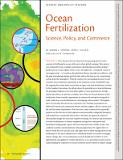Ocean Fertilization: Science, Policy, and Commerce
Author(s)
Strong, Aaron L.; Cullen, John J.; Chisholm, Sallie (Penny)
DownloadChisholm_Ocean Fertilization.pdf (1.039Mb)
PUBLISHER_POLICY
Publisher Policy
Article is made available in accordance with the publisher's policy and may be subject to US copyright law. Please refer to the publisher's site for terms of use.
Terms of use
Metadata
Show full item recordAbstract
Over the past 20 years there has been growing interest in the concept of fertilizing the ocean with iron to abate global warming. This interest was catalyzed by basic scientific experiments showing that iron limits primary production in certain regions of the ocean. The approach—considered a form of “geoengineering”—is to induce phytoplankton blooms through iron addition, with the goal of producing organic particles that sink to the deep ocean, sequestering carbon from the atmosphere. With the controversy surrounding the most recent scientific iron fertilization experiment in the Southern Ocean (LOHAFEX) and the ongoing discussion about restrictions on large-scale iron fertilization activities by the London Convention, the debate about the potential use of iron fertilization for geoengineering has never been more public or more pronounced. To help
inform this debate, we present a synoptic view of the two-decade history of iron
fertilization, from scientific experiments to commercial enterprises designed to
trade credits for ocean fertilization on a developing carbon market. Throughout
these two decades there has been a repeated cycle: Scientific experiments are followed by media and commercial interest and this triggers calls for caution and the need for more experiments. Over the years, some scientists have repeatedly pointed out that the idea is both unproven and potentially ecologically disruptive, and models have consistently shown that at the limit, the approach could not substantially change the trajectory of global warming. Yet, interest and investment in ocean fertilization as a climate mitigation strategy have only grown and intensified, fueling media reports that have misconstrued scientific results, and conflated scientific experimentation with geoengineering. We suggest that it is time to break this two-decade cycle, and argue that we know enough about ocean fertilization to say that it should not be considered further as a means to mitigate climate change. But, ocean fertilization research should not be halted: if used appropriately and applied to testable hypotheses, it is a powerful research tool for understanding the responses of ocean ecosystems in the context of climate change.
Date issued
2009-09Department
Massachusetts Institute of Technology. Department of Biology; Massachusetts Institute of Technology. Department of Civil and Environmental EngineeringJournal
Oceanography
Publisher
The Oceanography Society
Citation
Strong, Aaron L., John J. Cullen, and Sallie W. Chisholm. "Ocean Fertilization: Science, Policy, and Commerce." Oceanography 22.3 (2009): 236–261.
Version: Final published version
ISSN
1042-8275